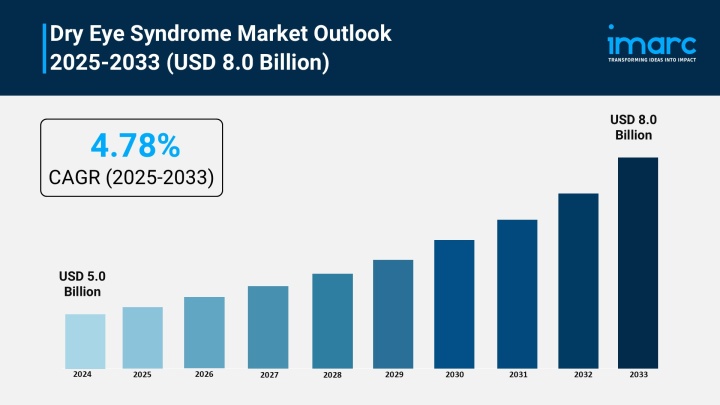Market Overview:
According to IMARC Group's latest research publication, "Dry Eye Syndrome Market: Global Industry Trends, Share, Size, Growth, Opportunity and Forecast 2025-2033", offers a comprehensive analysis of the industry, which comprises insights on the global dry eye syndrome market share. The global market size reached USD 5.0 Billion in 2024. Looking forward, IMARC Group expects the market to reach USD 8.0 Billion by 2033, exhibiting a growth rate (CAGR) of 4.78% during 2025-2033.
This detailed analysis primarily encompasses industry size, business trends, market share, key growth factors, and regional forecasts. The report offers a comprehensive overview and integrates research findings, market assessments, and data from different sources. It also includes pivotal market dynamics like drivers and challenges, while also highlighting growth opportunities, financial insights, technological improvements, emerging trends, and innovations. Besides this, the report provides regional market evaluation, along with a competitive landscape analysis.
How AI is Reshaping the Future of Dry Eye Syndrome Market
- AI enhances diagnostic accuracy by analyzing tear film breakup time and ocular surface images, reducing misdiagnosis rates by up to 20% through advanced pattern recognition algorithms.
- Machine learning models process diverse diagnostic evidence from multiple sources, enabling more objective and standardized diagnosis of dry eye disease across clinical settings.
- AI-powered imaging systems analyze slit-lamp videos and optical coherence tomography images to detect subtle dry eye indicators that human observers might miss, improving early detection rates.
- Predictive analytics help ophthalmologists personalize treatment plans based on patient data, symptoms severity, and response patterns, with 85% of clinics reporting improved treatment outcomes.
- Smart diagnostic devices integrated with AI algorithms streamline tear film assessment and meibomian gland evaluation, reducing examination time by 30% while maintaining high diagnostic precision.
Download a sample PDF of this report: https://www.imarcgroup.com/dry-eye-syndrome-market/requestsample
Key Trends in the Dry Eye Syndrome Market
- Rising Screen Time and Digital Eye Strain: Office workers spend an average of 6.5 hours daily on screens, with Americans averaging nearly 11 hours of total screen time. Remote work culture extends digital exposure, decreasing blink frequency and causing eye dryness. Digital eye strain-induced dry eye drives demand for OTC artificial tears and prescription treatments.
- Aging Population Driving Demand: The geriatric population is particularly vulnerable to dry eye syndrome due to natural tear production decline. Chronic health medications in elderly patients often exacerbate symptoms. Healthcare systems face increased demand for lubricating drops, prescription medications, and specialized eye care services for age-related conditions.
- Advanced Therapeutic Innovations: FDA approvals of novel treatments like TRYPTYR (acoltremon), CEQUA (cyclosporine 0.09%), and LACRIFILL Canalicular Gel are revolutionizing care. Anti-inflammatory drugs hold 53.3% market share, with preservative-free formulations and sustained-release options improving patient compliance and therapeutic outcomes.
- Environmental Pollution Impact: WHO estimates 90% of the global population is exposed to polluted air, with airborne particles causing eye irritation and aggravating symptoms. Indoor pollutants like VOCs from cleaning products reduce air quality. Climate change alters humidity levels, increasing tear evaporation rates especially in arid regions.
- Telemedicine and Digital Health Solutions: Teleophthalmology adoption is rising in remote areas, improving diagnosis and follow-up care accessibility. Wearable diagnostics and mobile health applications help tailor individualized treatment approaches. Digital platforms facilitate patient education and early intervention, with 40% of patients preferring virtual consultations for routine monitoring.
Growth Factors in the Dry Eye Syndrome Market
- Increasing Disease Prevalence: Dry eye disease affects 5-50% of the population depending on diagnostic criteria, yet remains underdiagnosed. Lifestyle factors including excessive screen use, air conditioning, and environmental pollutants are increasing incidence rates. Chronic nature requires ongoing management, driving sustained demand for therapeutic products.
- Advanced Diagnostic Technologies: TearLab Osmolarity System and Smart Eye Camera devices enable precise assessments. Innovations in diagnostic imaging and AI-powered analysis tools improve detection rates. Enhanced diagnostic capabilities lead to earlier identification and treatment initiation, expanding the patient pool seeking intervention.
- Healthcare Infrastructure Expansion: North America's robust healthcare system with extensive insurance coverage facilitates treatment access. Hospital pharmacies hold 56.3% market share, providing immediate access to prescription medications. Specialized ophthalmology networks in hospitals and clinics support prompt diagnosis and comprehensive care delivery.
- Government Support and Awareness Programs: National Eye Institute funding for vision research fortifies market development. Educational campaigns by organizations like the American Optometric Association encourage early diagnosis. EU's regulatory frameworks with CE Mark approval facilitate novel therapy availability, accelerating market penetration.
- Product Innovation and Development: Liquid drops dominate with 59.3% market share due to versatility and ease of use. Companies develop preservative-free options, multi-dose vials, and compounded formulas for complex cases. New formulations including thermal pulsation devices and autologous serum eye drops address diverse patient needs, driving 25% of market growth.
Leading Companies Operating in the Global Dry Eye Syndrome Industry:
- Akorn Operating Company LLC
- Alimera Science
- Allergan plc
- Auven Therapeutics
- Bausch + Lomb Incorporated
- GlaxoSmithKline plc
- Nicox S.A.
- Novartis AG
- Otsuka Holdings Co., Ltd.
- Santen Pharmaceutical Co., Ltd.
Dry Eye Syndrome Market Report Segmentation:
Breakup By Disease Type:
- Evaporative Dry Eye Syndrome
- Aqueous Dry Eye Syndrome
Evaporative dry eye syndrome accounts for the majority of shares with 75.5% market share due to high prevalence linked to modern lifestyle choices including prolonged digital screen use, air conditioning reliance, and environmental pollutant exposure.
Breakup By Drug Type:
- Anti-inflammatory Drugs
- Lubricant Eye Drops
- Autologous Serum Eye Drops
Anti-inflammatory drugs dominate with 53.3% market share as inflammation is a major contributing factor in dry eye conditions, with medications including cyclosporine, corticosteroids, and NSAIDs providing effective symptom relief.
Breakup By Product:
- Liquid Drops
- Gel
- Liquid Wipes
- Eye Ointment
- Others
Liquid drops hold 59.3% market share on account of their versatility, effectiveness, and ease of use for various eye conditions, offering non-invasive solutions for instant symptom relief.
Breakup By Distribution Channel:
- Hospital Pharmacies
- Retail Pharmacies
- Online Pharmacies
Hospital pharmacies lead with 56.3% market share due to their crucial role in delivering specialist eye care treatments and ensuring access to prescription medications following ophthalmologist diagnoses.
Breakup By Region:
- North America (United States, Canada)
- Asia Pacific (China, Japan, India, South Korea, Australia, Indonesia, Others)
- Europe (Germany, France, United Kingdom, Italy, Spain, Russia, Others)
- Latin America (Brazil, Mexico, Others)
- Middle East and Africa
North America enjoys the leading position with over 55.0% market share owing to advanced healthcare infrastructure, high prevalence of eye conditions, substantial R&D investment, and widespread insurance coverage for eye care.
Recent News and Developments in Dry Eye Syndrome Market
- May 2025: Alcon announced FDA approval of TRYPTYR (acoltremon ophthalmic solution) 0.003%, the first TRPM8-targeting eye drop for dry eye disease, stimulating natural tear production as early as day one of treatment.
- May 2024: Nordic Pharma, Inc. launched LACRIFILL Canalicular Gel, a novel FDA-cleared treatment using cross-linked hyaluronic acid gel to temporarily block tear drainage, allowing natural tears to bathe the eyes more effectively.
- 2023: Orbis International administered over 8.8 million doses of azithromycin in Ethiopia as part of trachoma elimination efforts, while conducting 400,000+ community eye screenings and attracting 192,000+ patients for eye care services.
Note: If you require specific details, data, or insights that are not currently included in the scope of this report, we are happy to accommodate your request. As part of our customization service, we will gather and provide the additional information you need, tailored to your specific requirements. Please let us know your exact needs, and we will ensure the report is updated accordingly to meet your expectations.
About Us:
IMARC Group is a global management consulting firm that helps the world's most ambitious changemakers to create a lasting impact. The company provide a comprehensive suite of market entry and expansion services. IMARC offerings include thorough market assessment, feasibility studies, company incorporation assistance, factory setup support, regulatory approvals and licensing navigation, branding, marketing and sales strategies, competitive landscape and benchmarking analyses, pricing and cost research, and procurement research.
Contact Us:
IMARC Group
134 N 4th St. Brooklyn, NY 11249, USA
Email: sales@imarcgroup.com
Tel No:(D) +91 120 433 0800
United States: +1-201971-6302


